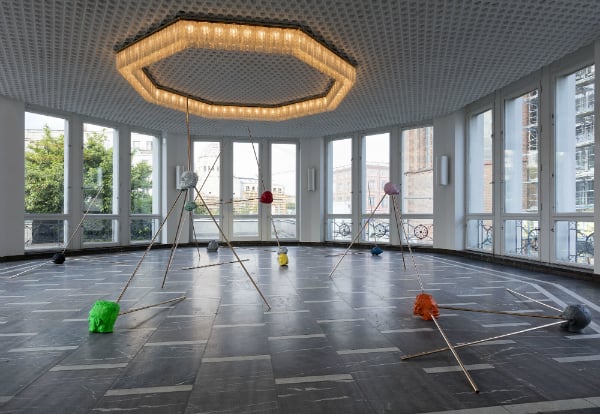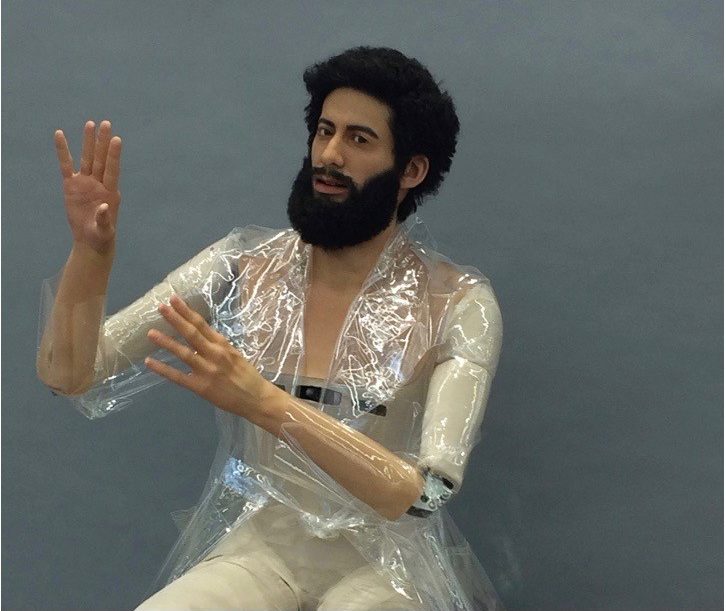Reviews
Goshka Macuga Imagines The End of Man… And It’s Glorious
Featuring an entire history of science and a handsome bearded humanoid.

Featuring an entire history of science and a handsome bearded humanoid.

Any discussion of Artificial Intelligence—machines’ ability to learn, accumulate knowledge, and communicate with each other—inevitably touches on possible scenarios of a hostile AI takeover, where superior machines will render their makers obsolete. Experts refer to this as AI’s inherent “existential risk.” But imagine a different proposition, in which machines can actually help to eliminate the very real “existential risk” that humans pose to themselves?
Polish born, London-based artist Goshka Macuga conjures up a world where technology masters the faculty that humans most badly lack, namely, to learn from our blood-drenched past. In her current exhibition at Berlin’s Schinkel Pavillon—which takes its cue from her recent show “To the Son of Man Who Ate the Scroll” at Fondazione Prada earlier this year—Macuga stages a spectacular exercise in mnemonics that reflects her intensive research into the methodological categorization of information in order to facilitate knowledge retention.

Goshka Macuga, detail from “Now this, is this the end … the end of the beginning or the beginning of the end?” (2016). Courtesy of Schinkel Pavillon, photo Andrea Rossetti.
The Berlin exhibition, ominously titled “Now this, is this the end … the end of the beginning or the beginning of the end?”, opened in two stages. The first, which coincided with the opening of the 9th Berlin Biennale in early June, included the artist’s “network” sculptures in the pavilion’s upper level. The second stage, which opened this past Friday, saw the much-anticipated arrival of Macuga’s striking humanoid that now occupies the same space. But we’ll get to the bearded android later.
The installation is reminiscent of molecules in its colorful, interlinked structures that connect painted bronze heads of thinkers, politicians, and historical figures into coherent systems representing the artist’s methodological organization of information. Titled International Institute of Intellectual Co-operation (2016), the work borrows its name from the International Institute for Intellectual Cooperation—affiliated with the League of Nations—which saw Albert Einstein and Sigmund Freud taking up correspondence in 1932 on the topic of war. Einstein addressed Freud with the existential question: “Is there any way of delivering mankind from the menace of war?”
For the Berlin version of the piece, Macuga focused on figures who are somehow related—more directly or by loose associations—to the notion of “the end of history” that political scientist Francis Fukuyama coined after the fall of the Iron Curtain. From very early thinkers of computational theory like Ramon Llull and later, Ada Lovelace, she wanders to Hegel, Marx, Gorbachev, Gagarin, Žižek, and even the Guerilla Girls, or Frankenstein. One can almost imagine these architectural representations fed into a virtual brain and memorized by androids, and wonder what conclusions they might arrive at by reverse engineering the artist’s own creative connotations.

Goshka Macuga, installation view of “Now this, is this the end…the end of the beginning or the beginning of the end?” (2016). Courtesy of Schinkel Pavillon, photo Andrea Rossetti.
But these memory palaces also display a physical connection to the exhibition space: the very difficult octagonal shape of the pavilion, built in then-East Berlin in 1969 by Soviet architect Richard Paulick, is offset by the irregular combinations. “Because of the structure of the pavilion, this feels like a magical space with a magical quality,” Macuga told artnet News during a walk through the exhibition.
Through the pavilion’s glass walls, Macuga is looking at the scaffolding enveloping the monstrous construction site across the street, the Humboldt Forum, which is essentially a reconstruction of Berlin’s baroque City Palace which was inhabited by the Kings of Prussia and the German Emperors. The €600 million project is being built where the Palace of the Republic, an East German hall for the people, once stood before it was razed to make place for this.
“It’s amazing that this city is changing to yet another vapid manifestation of capitalism,” says Macuga, who grew up in the Eastern Bloc. “You could think 10 years ago when all the artists and intellectuals gathered here, that it would develop into something else. But it’s changing into a monster and that palace is a representation of this failure,” she says pointing out the window.
Looking back at her sculptures, she comments, “This relates to the end of time, but also to the lack of time—there’s a tribe in Malaysia that lives without the notion of time! Frankenstein and Darwin are here because it’s also about the limits of humanity from the evolutionary point of view, and the end of man, when it becomes something different than a human being.”

Goshka Macuga, To the Son of the Man who Ate the Scroll, (2016). Courtesy of Schinkel Pavillon.
It’s in fact an interesting artistic device to replace a work in the middle of the show’s run. Having served as a sort of a prologue, the sculptures have now been replaced by the android, Macuga’s own Frankenstein.
Created by A-Lab in Japan, the very realistic looking humanoid blinks, moves his hands, and turns his head as he calmly recites a monologue pieced together from excerpts of history’s greatest orations as well as sci-fi narratives. He is a repository of human speech for a post-human world, enchanting whom ever is left around to listen with his soft but authoritative voice. Walking in on his speech is highly uncanny, for though he may spout the wisdom of ages, he’s suggestive of a future in which mankind has annihilated itself, and machines recite history’s lessons to avert further extinctions.
https://instagram.com/p/BEBD81PnldK/?taken-by=hiliperl
It’s seems like a logical extension of this vision that the artist would also approach the topic of human creativity in this coherent show as well. For the pavilion’s lower level, Macuga created the installation Before the Beginning and After the End, Beginning (2016), a collaboration with the artist Patrick Tresset.
Tresset developed a robotic arm that draws on a long paper scroll which is rolled out on a rectangular table that cuts across the space. Here, we see Macuga’s return to her initial practice of incorporating other artists’ work into new suggested environments and connections. She places artworks by different artists—such as Nina Canell, Daniel Silver, Jonathan Monk—along the table, mapping out an abbreviated run-through of human ingenuity dotted with man made artifacts. This installation, too, is a scaled down, more intimate version of a work seen at Prada Foundation.
The robotic arm was fed with information such as the standard Einstein Big Bang model and gravitational equation, which it sketches line after staccatoed line on the scroll, while Canell’s work, pertaining to electricity, is placed in its vicinity. Planetary constellations, the creation of plants and animate beings and other concepts from the natural sciences or metaphysics are drawn by the machine, following a chronological order of sorts. The robot’s drawings conflate aeons, revealing a retrospective point of view, again, from a post-human time.

Goshka Macuga, installation view of “Now this, is this the end … the end of the beginning or
the beginning of the end?” (2016). Courtesy of Schinkel Pavillon, photo Andrea Rossetti.
Here, Macuga probes the current limits of AI, as if asking, can the robots learn to be creative, inventive, observant? On the walls, she hung a drawing by Carl Andre, and another by Hanne Darboven, two artists who also proposed systems and categories in their work, where the dimension of time, however, is perceived from very human perspective.
Despite its proposing of a post human condition that benefits from our mistakes, this is an utterly “human” show that relies on first-hand experience, reactions, and emotions. You can almost feel the synapses in your brain firing up while making connections between the elements on display. The history of science and that of philosophy wouldn’t inspire the same feelings of awe, pleasure, and anxiety in machines, no matter how much you fine-tune the android.
Goshka Macuga, “Now this, is this the end … the end of the beginning or the beginning of the end?” is on view at the Schinkel Pavillon, Berlin from 3 June – 18 September, 2016.